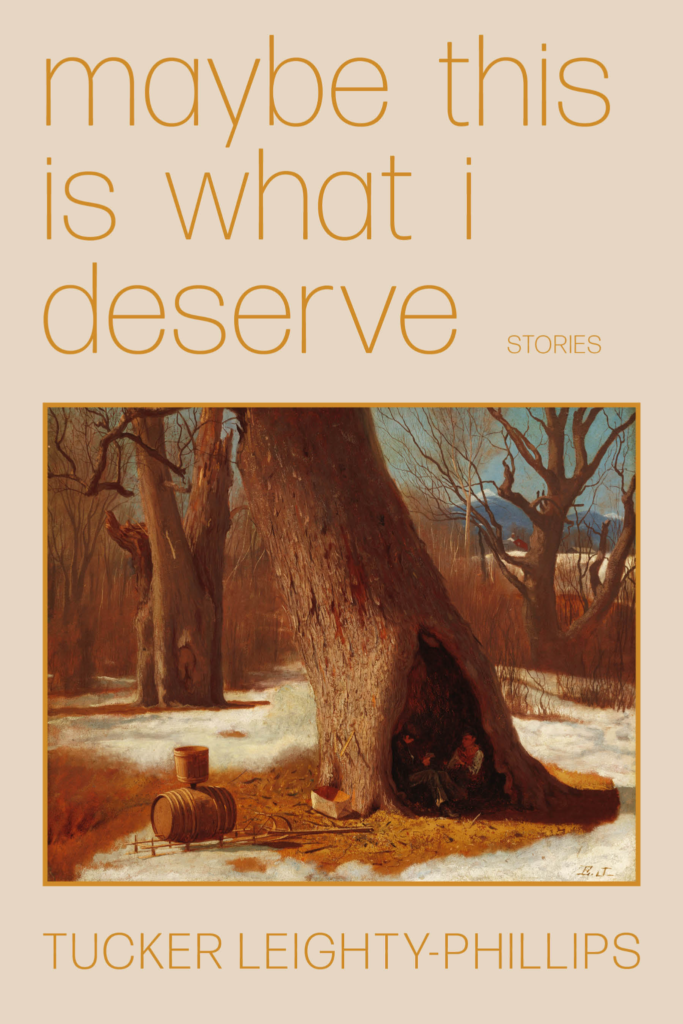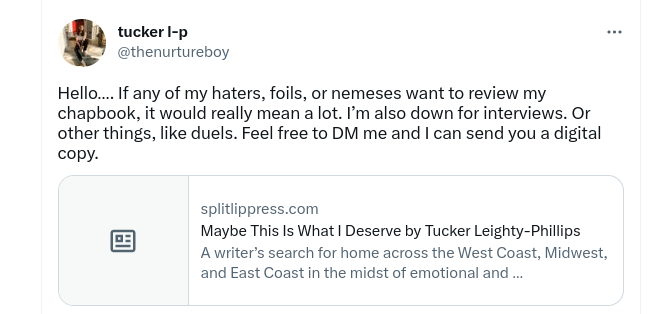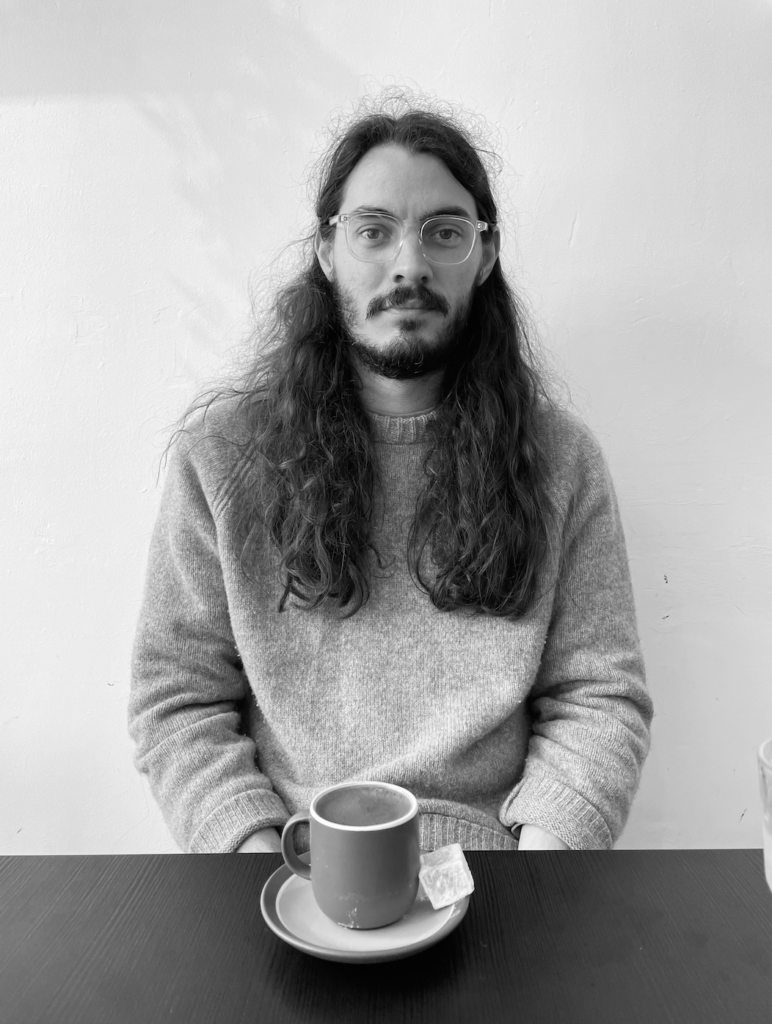Interview with Tucker Leighty-Phillips
By Charlotte Hamrick

Although Twitter is getting lots of shade thrown at it lately, I still enjoy the fact that I can find new-to-me writers on it. I have my favorite widely-published writers, as everyone does, but there’s a special thrill when I read work by someone I’ve never read and connect with their work. It’s the mystery element that piques my interest – what voice am I about to meet?
I don’t know how I missed reading Tucker Leighty-Phillips before I chanced across his tweet in early March:

Clearly, Twitter thought I should “meet” him. Twitter was right.
I was blown away by his forthcoming collection, Maybe This is What I Deserve, published by Split Lip Press and winner of their 2022 chapbook competition. It is an extraordinary read. I talked to Tucker about the collection for Reckon Review.
Tucker, thank you for agreeing to be interviewed for my column “The Nitty Gritty” in Reckon Review.
You’ve included so many interesting stories in this collection that I wish we could talk about each and every one. I was amazed by the creativity and imagination you infused in them in addition to giving me (the reader) situations to really think about long after the read is over. It was a rare pleasure for me to love every story.
On the surface of your opening story, “Down the Tunnel, Up the Slide,” the reader is given a scene of a child playing in a burger joint play pit while their dad is getting a burger. But there are so many layers in this story beyond the obvious. Without spoiling, why did you decide to open your collection with this piece? (I think it’s perfect!)
Thank you! There were a couple of reasons, but I think what really made this story stand out to me as the opener is that it features a physical embodiment of what so much of this collection contains–a child entering a space that adults can’t exist in; a space of wonder; a space of escape; a space of possibility. There are material conditions and issues just beyond this world, but for the moment, they don’t matter. These kids are kicking off their shoes, climbing through tunnels, and finding a space where they can exist with one another. It’s like a more tender Children of the Corn!
“Togethering” is so effective in bringing out empathy and made me really think of what it might be like to lose the ability to communicate. I’m curious if this story was written out of real life experience or if it’s all intuition and research on your part.
That story was born out of a workshop with Tara Ison, who always does a lot of great work on defamiliarization in fiction. She asked us to find something to defamiliarize, and I opted for language. I wanted to write a story that explored what might happen when our relationship to language becomes completely subverted. Of course, it is also a breakup story–and in any waning relationship, language takes on new meaning–what is said, what isn’t said; how things are said and what we might actually mean.
It struck me how the first part of this collection included stories with a surreal component. Then, beginning with “The Hollister Store”, you write in a more traditional storytelling style (imo). Was that a conscious choice or serendipity? Because I really loved how effortlessly the gears shifted, highlighting how you’re able to write compellingly in different styles while still keeping the Tucker LP voice.
I think about this question a lot–because I do tend to go back and forth between fabulism and realism, and sometimes the two can get blended together. For me, I think my willingness to engage with the surreal really depends on the story and the topic. If I feel like I’m exploring something that is familiar, I might look for an angle in which the topic or idea hasn’t been explored before. If I feel like I’m treading lesser-recognizable territory, I might stay grounded in the idea and stay as close to the experience as possible. In the story you reference, I was really trying to get across how the Hollister Store at the mall was such an emblem of millennial culture through lenses like class status and body image. So in a way, the store itself became an unfamiliar way to explore those ideas.
As someone who cannot write surrealism to save my life, what’s your secret for tapping into that mindset?
Lord, I don’t know if I can impart advice. For me personally, surrealist art doesn’t aim to explain but to evoke–to create circumstances and synergies that make the audience/reader/participants engage critically through the frame of unfamiliarity. When you see a painting of, I dunno, a melting clock, the work is on you to engage with that image and make sense of it. I’m not a surrealism scholar, but I like that; the work of reimagining this world, and other worlds, and seeing if you can make people feel something new. It feels almost utopian–maybe there are new feelings out there, ones we haven’t even imagined.
If you want practical advice, I like to try what I call “story soup”–making a list of my interests, things that excite me, research topics, whatever; and then choosing a couple at random and jamming them together. Sometimes that means I pull a couple strange things from the hat, maybe it’s “lizards” and “fire department haunted houses”–and I’m tasked with finding a way to combine those two topics into one. You gotta trust yourself to explore, even if there’s not a fully-fleshed idea. That’s how you build confidence–creating something when it isn’t easy.
That’s a great technique! I’m going to try it.
I was impressed with how you illustrated the class divide in “The Hollister Store” and “Clem’s Second Refrigerator.” In “Clem’s” the main character’s thoughts about the fridge are simple, direct, and so effective. Tell us a little about the inspiration for this piece.
This was one of the more directly autobiographical stories. When I was a kid, I believed that houses with second refrigerators were the houses where luxury flourished. I think it felt like a revelation to me, this understanding of how others lived–so it made sense for the story to be a spiritual text that dips into the Haves and the Have-Nots.
My favorite of the collection is “Midge Woke to Discover She’d Become a Lightning Bug.” It’s about being “different” or not part of what society decided is “normal.” The ending is brilliant. How did you choose a lightning bug as the catalyst in this story?
This was one of the stories that came from my story soup approach! I was interested in exploring puberty as a concept, but didn’t really like the approaches I’d tried. So I went to my list, and settled on “lightning bugs” and “high school theater”–and this was the result! I had also been really into the idea of writing stories that felt like jokes–a setup, callback, and punchline. It’s been fun to read in public, because I get to see whether or not the punchline works. It’s fifty-fifty!
I noticed insects and non-human beings playing a part in several stories; the lightning bug, lice, whale, catfish, silver-taloned monster. It’s interesting how you use these to flip a paradigm or illuminate an issue in the stories. I’m not sure what I’m trying to ask here except I’m curious how you decide what non-human character to include. For instance, in the “Catfish Wishing Well,” which is wildly creative. Where did the idea for a catfish come from?
Typically, it’s animals I have a relationship with. Catfish remind me of pay lakes, which I visited when I was a kid with my stepfather. For those unfamiliar, a pay lake is usually a large pond that is stocked with fish, and you can pay a set fee to fish there. If you’re someone who is impatient, it might yield higher returns than sitting on a riverbank or under a bridge. I don’t know, I don’t really fish. But I remember my stepdad catching catfish at the pay lake. I think those memories are kind of charged in weird ways for me, so I always wanted to make space for a catfish. Sometimes, the animals I use are region-specific, or animals I associate with home. Sometimes, it’s chosen as semi-random, or for the sake of driving a narrative, like the lightning bug.
Children, their experiences and points of view are recurrent themes in your stories. Why do you think that is?
Childhood is massively important to my artistic practice. It’s a time where everything is new, wondrous, a little overwhelming. Everything feels big. Have you ever visited a place that you remembered from childhood? It’s always so much smaller when you’re older. I miss that largeness of being young. A grocery store feels like an airplane hangar. Childhood’s a period where you haven’t really established routine yet. There’s so much to learn. You want to touch the stove. I write about childhood as a means of exploration, to make sense of who I am in the world, and to try to return to that space, that stove-touching space.
I love the perfect last line in the last story, “The Aliens.” I did not want this collection to end. (smiles)
Ha, thanks! Oddly enough, that’s part of the reason why that story closes the collection (and why “Down the Tunnel” opens–since that story starts with ‘This is how it begins’).
Now for a few more general questions about your writing.
Do you remember your first story? What was it about?
I didn’t start seriously writing until I was in my mid-twenties, but I did write a one-off short story during Algebra class in eighth grade. Someone had given me a journal for Christmas, and I decided I’d write a story in the journal. I had no idea what epistolary writing was, but technically, my first short story was one. I wrote this story about a man in hiding from some scary, powerful entity, and on the final page he revealed he was the president. It was so bad! But I’ll always remember the time I spent working on it and how much that meant to me, being creative, exploring an idea, following through and making something. It was really wonderful. I failed algebra.
Is flash fiction your primary genre? Do you work in any others?
I do work in a few other forms and mediums, I’m just not as widely published outside of flash fiction. I have a couple long-form projects that I’m always kicking around, and hopefully I’ll be able to share them with folks eventually–I’m just always so hesitant to talk about them!
How do you know when a story is finished?
Well, I will whittle a story down to the point where I think I’ve edited it to completion, and then I’ll send it to a friend and immediately realize the issues with it. I highly recommend finding a friend who will let you prematurely send over a story, say “oh wait, read this one instead!” and send a follow-up email with a new document called “New Story finalFINAL.doc”
Do you have a favorite place to write, music you listen to, or any sort of ritual that supports your creativity?
I’ve always had a lot of trouble listening to things while I write. I’ve always liked the idea of it, you know, putting on a funky country album so you can write something that feels earthy and soulful, but I’ve just never been able to focus. I think my biggest ritual is the sort of mental pre-writing I do in advance of most stories I write. I’ll think through the process of a story long before I start writing it, and I’ll usually write a bit, map things out, and then take a walk or a shower. Showers are great because I literally can’t find any other distraction–it’s just me and my mind and the shampoo. I’ve found that showers are great for creative problem solving.
What was the strangest place or experience that inspired you to write a story and how did it turn out?
You know, I haven’t ever really been able to do much with the strange experiences or places of my life. I think, whenever something wild happens to me, or I visit somewhere extravagant, I feel like I can’t really compete with the reality of the thing. Most of my work explores the mundane, and I’m at a point where I think I’m fine with that. I don’t know if I’m necessarily a “quiet” writer (which, what does that even mean, you know), but I definitely don’t feel like I’m wildly vibrant. I did publish a story a few years ago based on a mummy exhibit I visited, and saw my first mummified bog person. I guess that’s strange!
Do you have any tips to share regarding motivation and/or discipline in completing a piece?
I finished grad school two years ago–and the most important motivator for me since then has been having an accountability friend. You know, invite someone over, have a little writing date, work quietly on things together. Eat some chips. Drink a seltzer. If you’ve got nobody local, find someone to sit on zoom with–muted and black-boxed.
Long distance chips and sips.
Please share a few links to your published pieces.
“Mr. Boggins,” The Journal
“Down the Tunnel, Up the Slide,” HaveHasHad
“Toddy’s Got Lice Again,” Cheap Pop Lit

Tucker Leighty-Phillips
Tucker Leighty-Phillips is a writer from Southeastern Kentucky. He is the author of the short story collection Maybe This Is What I Deserve (Split/Lip Press, June 2023). He lives in Whitesburg, Kentucky, where he works for Appalshop’s Roadside Theater. Learn more at TuckerLP.net. Tucker’s collection can be pre ordered directly from Split/Lip Press.

Charlotte Hamrick
Charlotte Hamrick’s creative writing and photography has been published in a number of literary journals and anthologies including Still: The Journal, The Citron Review, Atticus Review, Reckon Review, Trampset, and New World Writing, among many others. Her fiction was selected for the Best Small Fictions 2022 anthology and she’s had several literary nominations including the Pushcart Prize, Best of the Net, Best Small Fictions, and Best Microfiction. She is the former Creative Nonfiction Editor for Barren Magazine and current Creative Nonfiction Editor for The Citron Review. She also writes intermittently on her Substack, The Hidden Hour. She lives in New Orleans with her husband and a menagerie of rescued pets where she sometimes does things other than read and write.
